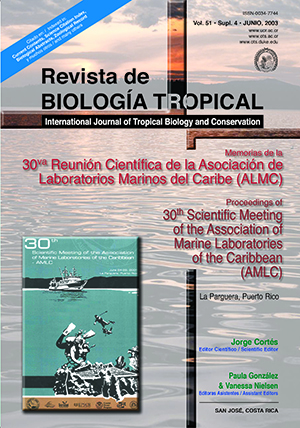Abstract
At the beginning of 1996 coral reefs in Morrocoy National Park, Venezuela, suffered an unprecedented mass mortality event. As a consequence, live coral cover dropped to 2-10%. One of the few reefs that kept live coral cover over 35% was Cayo Sombrero; nonetheless, the presence of some coral diseases has been detected within the past 2 years, representing a new source of coral mortality. Due to this situation, this study started a monitoring program on the incidence of coral diseases and syndromes in the reef of Cayo Sombrero. The CARICOMP protocol was used in order to evaluate reef health. Ten parallel band-transects (20 x 2m) where established at two depth intervals: Five between 3-8 m and five between 8-12 m, and the frequency of both, healthy and unhealthy colonies of each coral species was recorded along each band transect. In addition to other sources of coral damage (predation, siltation, etc), significant differences in disease incidence between the two depths intervals were tested with a Kruskall-Wallis test. The main problems observed were coral diseases such as yellow band (4,2%), dark spots (1.61%) and white plague-II (1.4%), mainly affecting Montastraea faveolata, M. annularis and Siderastrea siderea. Siltation, affecting massive colonies, such as Colpophyllia natans and Diploria strigosa; algae overgrowth, predation, anchor damage, and bleaching. Significant differences were found in the incidence of unhealthy (Kruskall-Wallis, p<0.05) bleached (Kruskall-Wallis, p < 0.05) and colonies affected by siltation (Kruskall-Wallis, p<0.05). More than 60% of the 585 coral colonies surveyed at both depths were found to be healthy, indicating that the Cayo Sombrero reef is still in good conditions compared to other localities in the Park. This study stresses the need to conduct early monitoring programs that survey coral disease incidence as a source of mortality for this coral reef.References
Antonius, A. & E. Ballesteros 1998. Epizoism: A new threat to coral health in Caribbean reefs. Rev. Biol. Trop. 46 (Supl. 5): 154-156.
Bone, D., A. Cróquer, E. Klein, D. Perez, F. Losada, M. Rada, J.J. Cruz, L. Galindo & P. Penchaszadeh. 2001. Programa Caricomp: Monitoreo continuo del Parque Nacional Morrocoy. Interciencia 26: 457-462.
Bruckner A.W. & R.J. Bruckner 1997. The persistence of black band disease in Jamaica: Impact on community structure. Proc. 8th Int. Coral Reef. Symp. 1: 601-606.
Dustan, P. 1977. Vitality of coral reef populations of Key Largo, Florida: recruitment and mortality. Environ. Geol. 2: 215-223.
Edmunds, P.J. 1991. Extent and effect of black band disease on Caribbean reef. Coral Reefs 10: 161-165.
García, A. 2001. Enfermedades y otras anomalías que afectan a los corales escleractínidos en algunas localidades del Parque Nacional Archipiélago de Los Roques. Tesis de Licenciatura, Universidad Central de Venezuela, Caracas, Venezuela. 169 p.
Garret, P. & H. Ducklow 1975. Coral disease in Bermuda. Nature 253: 349-350.
Garzón–Ferreira, J. & D.L. Gil 1998. Another unknown Caribbean coral phenomenon? Reef Encounter 24:10.
Green E. P. & A.W. Bruckner. 2000. The significance of coral disease epizootiology for coral reef conservation. Biol. Conserv. 96: 347-361.
Harvell, C.D., K. Kim, J.M. Burkholder, R.R. Colwell, P.R. Epstein, D.J. Grimes, E.E. Hofmann, E.K. Lipp, A.D. Osterhaus, R.M. Overstreet, J.W. Porter, G.W. Smith & G.R. Vasta 1999. Emerging marine diseasesclimate links and anthropogenic factors. Science 285: 1505-1510.
Laboy-Nieves, E.N., E. Klein, J.E. Conde, F. Losada, J.J. Cruz & D. Bone. 2001. Mass Mortality of tropical marine communities in Morrocoy, Venezuela. Bull. Mar. Sci. 68: 163-179.
Richardson, L.L. 1997. Occurrence of the black band disease cyanobacterium on healthy corals of the Florida Keys. Bull. Mar. Sci. 61: 485-490.
Richardson, L.L. 1998. Coral disease: what is really know? Trends Ecol. Evol. 13: 438-443.
Richardson L.L., W.M. Goldberg, R.G. Carlton & J.C. Halas. 1998a. Coral disease outbreak in the Florida Keys: Plague Type II. Rev. Biol. Trop. 46 (Supl. 5): 187-198.
Richardson L.L., W.M. Goldberg, K.G. Kuta, R.B. Aronson, G.W. Smith, K.B. Ritchie, L.C. Halas, J.S. Feingold & S.L. Miller. 1998b. Florida´s mystery coral-killer identified. Nature 392: 557-558.
Santavy, D.L., E.C. Peters, C. Quirolo, J.W. Porter & N. Bianchi 1999. Yellow-blotch disease outbreak on reefs of the San Blas Islands, Panama. Coral Reefs 18:97.
Weil, E. I. Urreiztieta & J. Garzón-Ferreira. (en prensa). Geographic variability in the incidence of coral and octocoral diseases in wider Caribbean. Proc. 9th Int. Coral Reef Symp. Indonesia.
##plugins.facebook.comentarios##

This work is licensed under a Creative Commons Attribution 4.0 International License.
Copyright (c) 2003 Revista de Biología Tropical


